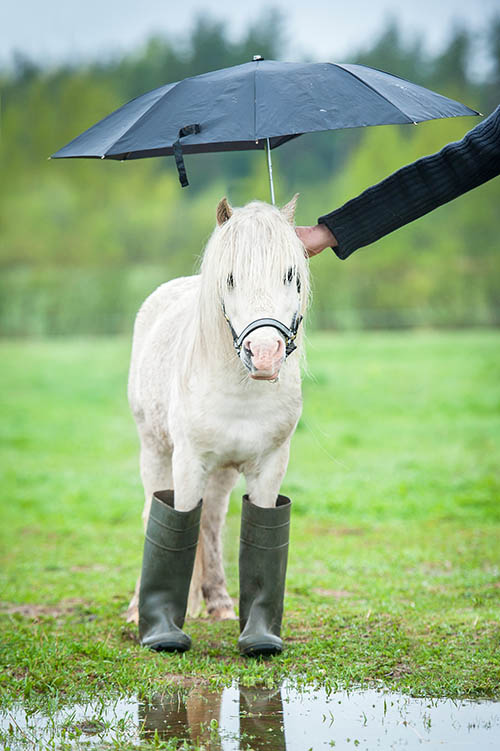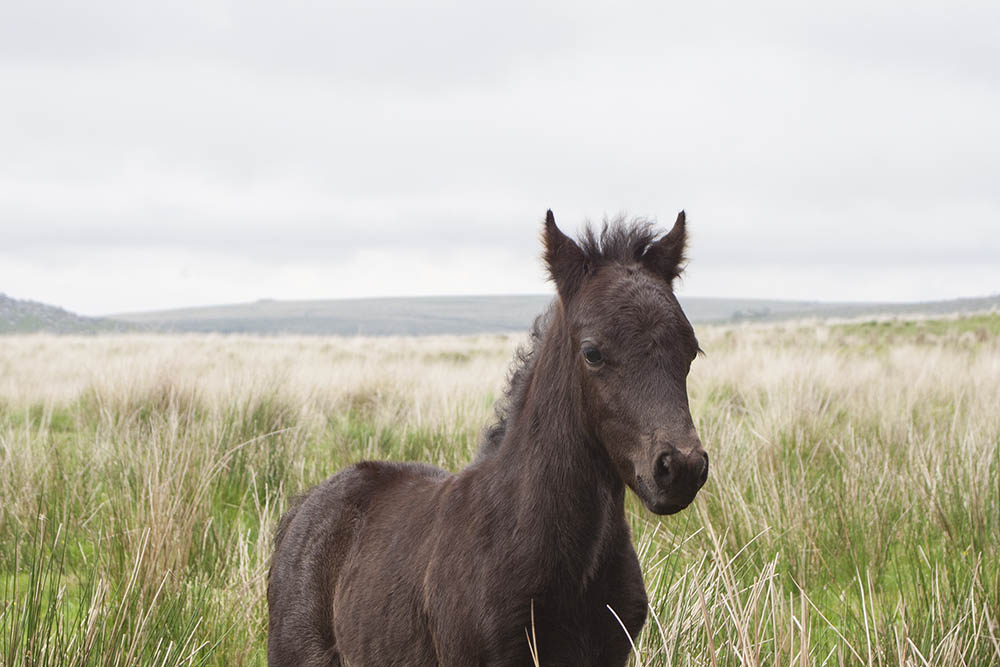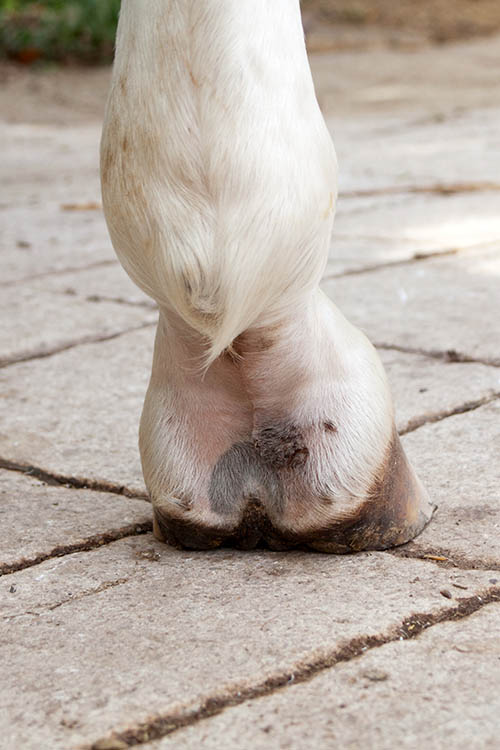With June the official start to winter (as if we southerners didn’t already know) it is time to remember to take extra precautions to help our horses cope with the colder and wetter months.

“It is important to periodically take off
the rugs to check that there are no issues.”
It is not a new concept that cold weather puts additional pressure on our horses, but for those of you who are new owners starting the journey with your equine friend, here are some helpful hints to minimise the negative impact the winter months can have on our horses.
The need to maintain body temperature is paramount all year round, so anything we can do to protect the horse from the extremes of the weather will reduce the reliance on the body’s reserves to maintain body condition. Geriatric horses, along with very young horses, will be more susceptible to the colder months and may have trouble maintaining their body weight and will often require extra care and support from their owners.
SHELTER
Providing shelter to paddocked horses is essential in any weather but is particularly important when the weather turns cold and the winds start picking up. A shed or a stable is ideal but not always practical. If possible, move horses to paddocks that have natural protection from the wind such as treed areas, protected valleys or gullies, dam banks or buildings.
If horses are tolerant of paddock mates, they can be placed in areas together so that when the temperatures drop or the winds get strong, they can huddle in a group to provide some protection to each other. This does not work for aggressive horses, but most horses will tolerate being mated with one or two others without incidence.
RUGGING
Rugging horses can provide good protection from the cold weather and therefore reduces the daily requirement of feed intake required to keep them warm. There are many variations to rugging, including double rugging (or multiple rugs), neck rugs and various combinations of types of rugs. It is important that rugs are correctly fitted as ill-fitting rugs can cause injuries, especially to pressure areas such as the top of the wither.
These injuries, if they occur, can take weeks to months to repair; therefore, taking the time to ensure that rugs fit correctly is well worth the effort. The use of bibs can reduce rubbing on the shoulder regions and can be padded to provide pressure relief around the withers, especially if the horse has a very prominent wither.
It is important to periodically take off the rugs to check that there are no issues going on under the rug that you are unaware of. Speaking from experience, I had bought a new rug for a horse that was just in a paddock eating grass and never ridden. The horse was bright and alert and happily eating, but when I took the rug off her several weeks later, she had not a skerrick of hair left on her body where the rug had been – no injuries, no sores, just bald!
I never made that mistake again. I would recommend that you check under the rug, even if it’s just lifting up the sides and running your hands over the body every 1-2 weeks to look for any signs that something is amiss or that the horse’s body weight has changed dramatically. Undoing the chest strap and folding the rug back will allow you to check the wither.



“Keep an eye on the body
condition score of your horse.”
FEEDING
Increasing the daily food intake is important as not only does the quality of the feed available in the paddocks decrease, but the demand for energy in the body increases. Even with rugging and shelter, many horses will lose body weight if their feed intake is not increased. Of note is the addition of hay into the horse’s diet. Hay is particularly good at warming up a horse’s body temperature because during the digestive process a lot of heat is produced. In ordinary circumstances, hay can be thought off as being an inefficient feed, as more energy is required to break the hay down during the digestive phase when compared to a grain feed.
However, this works as a bonus during the winter as the by-product of inefficient digestion is heat, so eating hay works like an internal combustion system. Keep an eye on the body condition score of your horse – if it is not maintaining its weight, it means it is not coping with winter (or it has an illness) and requires additional support.



DRIER GROUND
Minimise the time horses spend standing in muddy areas or in wet paddocks. Winter is the peak season for foot abscesses and ailments such as thrush and pastern dermatitis (mud fever, greasy heel). Standing in wet, muddy environments causes the feet to soften and the white line to swell, allowing bacteria to penetrate the foot. Once the bacteria are inside the hoof wall, they form an abscess (a walled-off infection) that is very painful and causes an obvious lameness to the horse. Most of these will work their way up the inside of the hoof wall and burst through the coronet band, unless a farrier or veterinarian can intervene earlier in the process and direct them to drain through the sole.
Once the abscess has burst or opened and drained, the lameness resolves, however, there is the potential for the infection to spread to underlying hoof structures causing serious damage and, on occasion, life threatening conditions. If we can avoid this scenario, it is better for everyone, especially the horse.
Pastern dermatitis is not dissimilar in that the wet muddy conditions cause the skin at the back of the pastern to soften and crack, allowing both bacterial and/or fungal element to gain entry and set up a nasty exudative (weeping) dermatitis. Once this is established, it can be very difficult to treat as the exudate from the affected skin causes more inflammation and damage to the surrounding skin, which further perpetuates the condition.
By doing small things like feeding the horse away from the gateways or areas where they tend to congregate, the deeper areas of mud can be minimised if not avoided. If possible, feed the horses on the higher elevations in the paddock, or in shelters, giving them the best opportunity to avoid standing in very wet areas.
OTHER AILMENTS
Mycotic dermatitis, also known as rain scald, is a skin disease more commonly seen in wet weather. When the skin is wet for extended periods, a bacterium called Dermatophilus congolensis can invade the skin and set up an infection that results in multiple crust lesions being formed. These usually occur along the back and rump areas of the horse, causing large areas of the hair to be matted and easily removed, leaving reddened areas of skin and pus exposed. It can occur in horses that are not rugged, but it is also important to note that it can also occur when rugs are put onto wet horses, hence it is another reason to check under the horse’s rug periodically over winter.
Lice are parasites that feed from the horse, causing the horse to itch, have scaley skin and lose patches of hair. They are more commonly seen in winter due to the lower temperatures, longer hair coats and close contact between animals. Horses are more susceptible to lice infections if they are ill, losing weight or under increased stress, so doing those extra things to minimise the negative effects of the cold can help avoid heavy lice burdens.
Heading into winter is a good time to remember that maximising good husbandry practices is the best way to have our horses in the best shape to cope with the months to follow. So, check your horse’s records and make sure that worming, dental maintenance, hoof trimming and vaccinations are all up to date, because the healthier they are going into the colder months, the better they will come through it. EQ
YOU MIGHT ALSO LIKE TO READ THE FOLLOWING BY DR MAXINE BRAIN:
The Ridden Horse Pain Ethogram – Equestrian Life, May 2021
The Benefits of Genetic Testing – Equestrian Life, April 2021
Heavy Metal Toxicities – Equestrian Life, March 2021
Euthanasia, the Toughest Decision – Equestrian Life, February 2021
How to Beat Heat Stress – Equestrian Life, January 2021
Medicinal Cannabis for Horses – Equestrian Life, December 2020
Foal Diarrhoea Part 2: Infectious Diarrhoea – Equestrian Life, November 2020
Foal Diarrhoea (Don’t Panic!) – Equestrian Life, October 2020
Urticaria Calls For Detective Work – Equestrian Life, September 2020
Winter’s Scourge, The Foot Abscess – Equestrian Life, August 2020
Core Strengthening & Balance Exercises – Equestrian Life, July 2020
The Principles of Rehabilitation – Equestrian Life, June 2020
When is Old, Too Old? – Equestrian Life, May 2020

